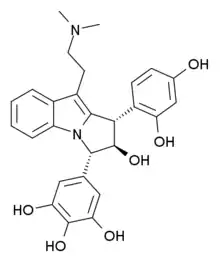Yuremamine
Yuremamine is a phytoindole alkaloid which was isolated from the bark of Mimosa tenuiflora in 2005, and erroneously assigned a pyrrolo[1,2-a]indole structure that was thought to represent a new class of indole alkaloids.[1] However, in 2015, the bioinspired total synthesis of yuremamine revealed its structure to be a flavonoid derivative.[2] It was also noted in the original isolation of yuremamine that the alkaloid occurs naturally as a purple solid, but total synthesis revealed that yuremamine as a free base is colorless, and the formation of a trifluoroacetate salt during HPLC purification is what led to the purple appearance.[2]
 Originally proposed chemical structure of yuremamine
Originally proposed chemical structure of yuremamine
 | |
| Names | |
|---|---|
| Other names
Yuremamine | |
| Identifiers | |
3D model (JSmol) |
|
| ChemSpider | |
PubChem CID |
|
| |
| |
| Properties | |
| C27H28N2O6 | |
| Molar mass | 476.529 g·mol−1 |
Except where otherwise noted, data are given for materials in their standard state (at 25 °C [77 °F], 100 kPa). | |
| Infobox references | |
References
- Vepsäläinen, J. J.; Auriola, S.; Tukiainen, M.; Ropponen, N. & Callaway, J. (2005). "Isolation and characterization of Yuremamine, a new phytoindole". Planta Medica. 71 (11): 1049–1053. doi:10.1055/s-2005-873131. PMID 16320208.
- Calvert, Matthew B.; Sperry, Jonathan (2015). "Bioinspired total synthesis and structural revision of yuremamine, an alkaloid from the entheogenic plant Mimosa tenuiflora". Chemical Communications. 51: 6202–6205. doi:10.1039/c5cc00380f.
External links
This article is issued from Wikipedia. The text is licensed under Creative Commons - Attribution - Sharealike. Additional terms may apply for the media files.